Home
KASHBA Asiatica
Ais Loupatty
Ton Lankreijer
Staalstraat 6
1011 JL Amsterdam
Open 12:00 – 17:00
Zondag / Sunday 14:00 - 17:00
Contact:
31-20 - 6 23 55 64
06 - 588 41 370
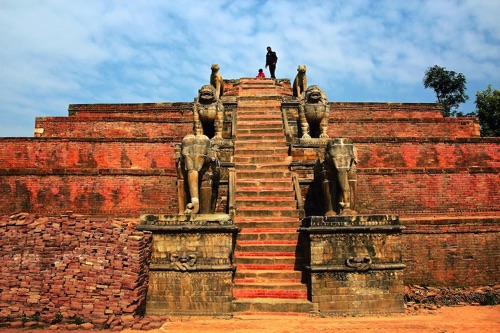
By hermetically sealing off a landlocked country, India not only shows contempt for international law, but follows a blatant strategy of destabilization as well.
Is Nepal being incorporated as an Indian state, is a new civil war developing, how many people are at risk of dying this winter from hunger and cold due to indifferent politicians and why does the rest of the world not interfere - despite all the collected international aid for earthquake victims being stopped at the border?
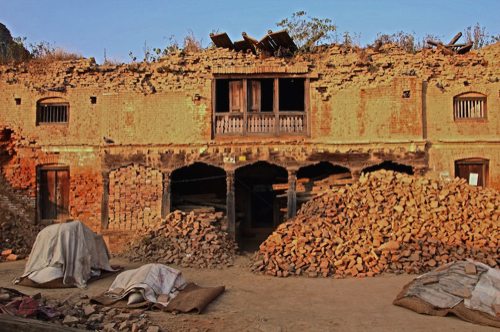
‘When will it come?’ an article about earthquakes in the Himalayas headlined in the Kathmandu Post January last year. Based on old scriptures and inscriptions in slabs of stone at temples and palaces, it had been calculated that the young mountain range had a pattern of coming into violent motion every eighty years or so - sometimes resulting in disastrous earthquakes.
At the time it did not seem a good idea to me to provoke the gods with such a headline when as a hindu you count 333.333 of them.

In the same newspaper Shekhar Koirala, the then Prime Minister, mentions in an interview: ‘The Tarai (the plains along the border with India- TL) occupies 17 percent of our land but nowadays around 51 percent of the population lives there. (…) We do not want to break the districts, though I agree it is largely because of our psyche.’

A little further he states: ‘We should be wary of the Western interest to keep Nepal under ‘controlled instability.’

To the west lies India, but possibly he took a broader view and hinted at the international geopolitical developments around the Pacific Ocean, the Pacific Rim.

At the time of Indira Gandhi non-aligned India preferred the Soviet Union to the United States as a friend. Even though CIA-documents on East Pakistan have in the meantime been released which show that Indira Gandhi had every reason not to trust Nixon and Kissinger, the relations are totally different now. The world 's most powerful democracy nowadays wants to be close friends with the world's greatest democracy.
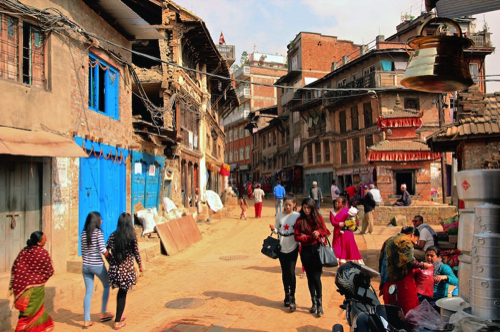
In other words: the US is trying to get India to cooperate in reducing China’s influence in Asia. The months-long, destabilizing boycott of Nepal seems to have become some kind of compensation in this sequel to Great Game..
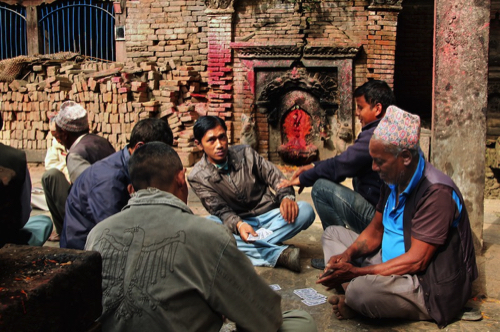
Tihar festival
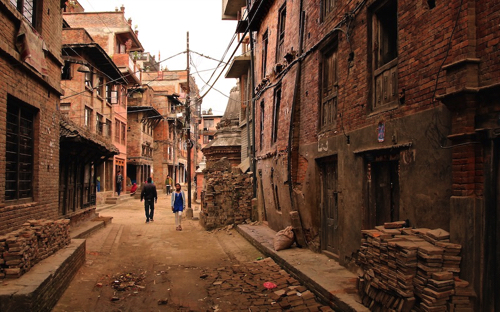
With great approval from its population, Nepal at last installed a new constitution on September 20th 2015.

After a ten-year period of civil war – in which a maoist guerilla fought its way out of the jungle into government seats causing some 17,000 casualties - and then some eight years of endless political bickering and trickery, a remarkable result was indeed achieved according to the politicians involved and international experts.
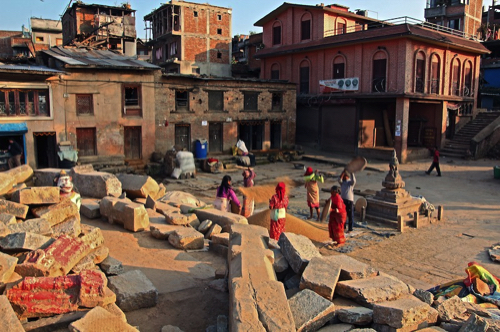
With great approval from its population, Nepal at last installed a new constitution on September 20th 2015.
After a ten-year period of civil war – in which a maoist guerilla fought its way out of the jungle into government seats causing some 17,000 casualties - and then some eight years of endless political bickering and trickery, a remarkable result was indeed achieved
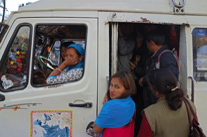
Victims and survivors are still waiting for truth and justice while thousands of ex-combatants are still fighting for their rights and support from the authorities. Conflict Victims Common Platform

The remarkable timing, shortly after the disastrous earthquakes, turned out to have been deliberate. Behind the scenes big neighbour India had been forestalling the new constitution for some time – they demanded changes – but now that Nepal stood in the
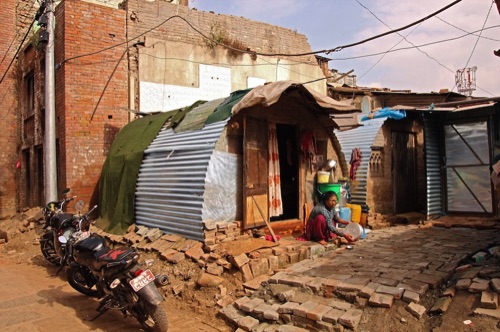
True, at the very last moment a number of women’s rights were taken out e.g. concerning marriage with foreigners – at the time few understood why – but ‘there is nothing in the new constitution that can not be changed by amendments.’ On the 145-nation Global Gender Gap 2015 Nepal even climbed two places to 110th.
Emmergency accommodation as a replacement for totally collapsed houses.
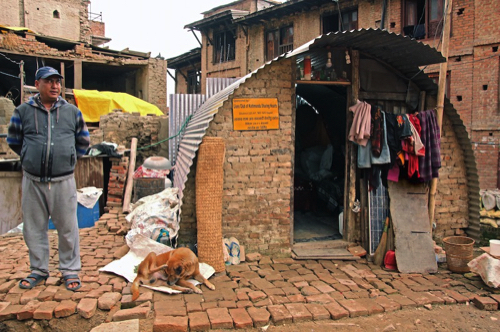
‘Some 250 different drafts circulate in the world,’ the first commission defended why it took so long.

‘After its independence in 1947, it took India some seven years,’ the next commission justified its long stay on the plush.
The earthquakes shook these cushions as well and the real reason, the underlying stalemate, came a bit more into the open.
From all over the world congratulations poured in. Except from India. President Modi declared he had taken note.
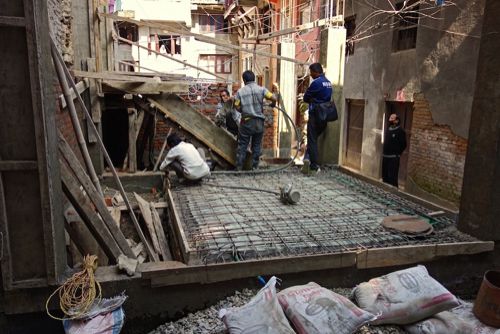
Eerste female president of the republic of Nepal.

The main demand was that the Nepalese inhabitants along the border with India – the 51% of the population Koirala mentioned at the beginning – would get voting rights percentagewise. No doubt India hoped thus to strengthen their grip on Nepalese domestic politics.
Thanks to a flash of nationalism, for the first time in its 250 year’s existence Nepal actually seemed socially united – at least the other 49%, the numerous minorities in the mountains.

‘We cannot bow down before anyone’s pressure or persuasion. It is a matter of our conscience and self-respect. This time Nepalese people have realized their 70-year-old dream of writing their own Constitution by themselves’, the Maoist chief Puspa Dahal told
Protest at visit of President Modi to London by Nepali and Sikhs.
Nearly every Nepali is aware of the fate that Sikkim befell. Two-thirds of the residents of this principality alongside Bhutan originally is of Nepalese origin and often still speaks in Nepalese dialects.

In 1973, the Indian Research and Analysis Wing (RAW) started to bombard and infiltrate Sikkim with targeted propaganda.
Two years later, after an enforced referendum, edited with lies, India

To what extent India considers adjoining Nepal as an extension of its own territory became clear last April. Immediately after the first earthquake, airplanes from many countries flew with reinforcements towards Kathmandu: Japan, China, UK, USA and even the Netherlands.
As a matter of course, the Indian army at once took over command at Kathmandu Airport. Without their passes no one could get in or out. In retrospect, the only surprising part may be that the soldiers actually left again.
Already several times Indian citizens have been arrested in Nepal because they turned out to be armed. Last 29 november , a group of thirteen men. A Nepalese government official was referring to the taking of Crimea, at which the Indian ambassador, dutifully, publicly fulminated.
To win last November’s elections in the neighbouring state of Bihar, the Indian President Modi used the situation in Nepal as pawn in his campaign. He appeased the residents of the border strip on the Nepalese side, the hindu Madhesi, hoping that they would go and vote for him in India.
This is possible because many of them have dual nationality. Given their hard lives, these documents are an expensive purchase.
From experience they know, however, that poor-in-money equals poor-in-rights, so options to
During a tour of Buddhist countries such as Vietnam and Laos, but in Germany as well, the hindu fundamentalist Modi boasted that the Sakyamuni Buddha was born in India. Obviously, the state of Nepal did not exist –but neither did the state of India.
The question arises whether from Modi’s perspective there exists

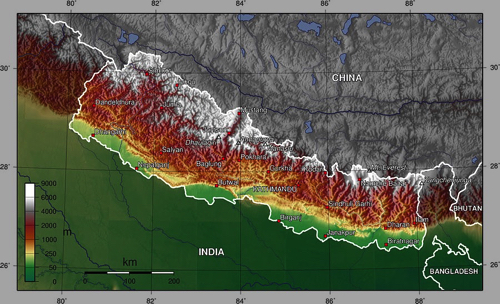

For centuries, the hill people of Nepal have been fed with anti-Madhesi concepts like Madhesis are unreliable and are not Nepali. They were required to carry permits to enter Kathmandu in the past. This was done to prevent mingling between the hill people and Madhesis. -Mangal Siddhi Manandhar
Together they could have been a threat to the Rana oligarchy; divide and rule.

To underline their demands to be included, the Madhesi parties stopped all imports at border towns.
C: Himalayan Times
As Nepal is enclosed by India – transport via the northern border, the Himalayas, is difficult, if not impossible, especially for containers and tankers - the Madhesi consequently have a very effective means of
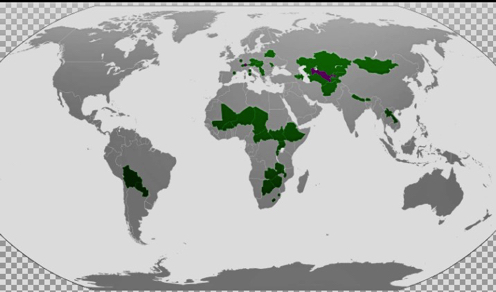
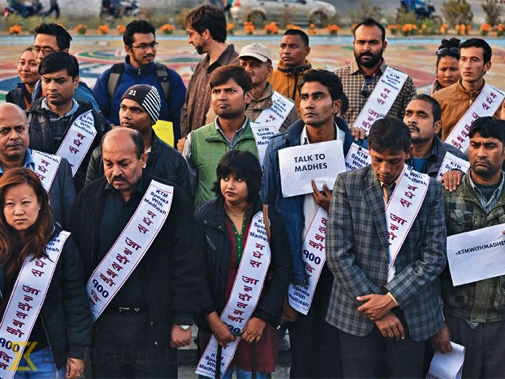
c: Kantipur

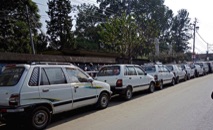
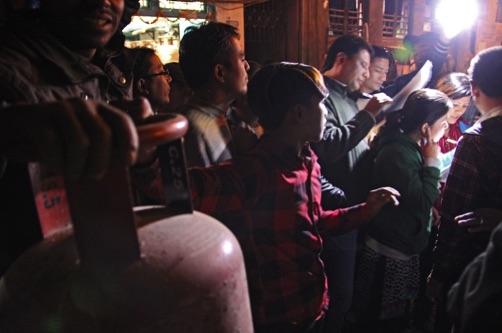


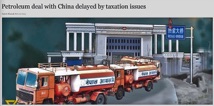

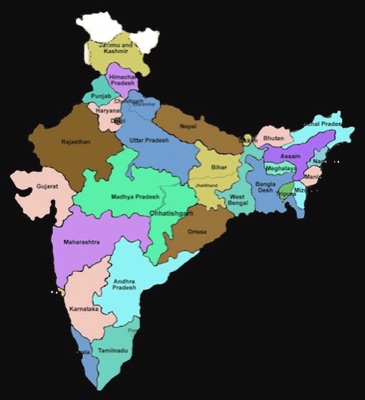
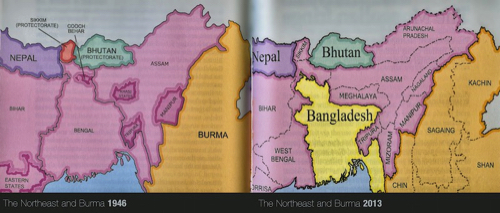

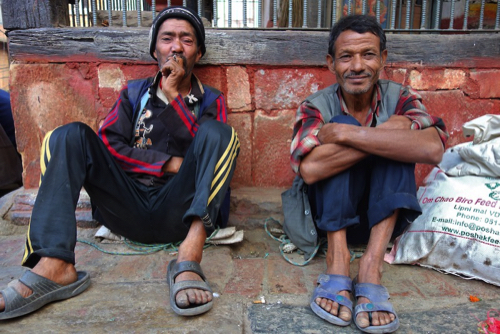
The US says it wants to withdraw from Afghanistan and tries to counteract the influence of Pakistan and China in the area by increasing India’s presence.
For India, the US holds the key to a number of international organizations, whether it is the UN Security Council or the Nuclear Suppliers Club.
India has had problems with its military imports from Russia. The shortfall in spares and the delay and increased cost of the aircraft carrier are some recent examples. Until its domestic defense industry comes of age, India would need to depend on imports to enhance its capabilities to continue to be a military power in Asia.
Therefore India has increased its import base and turned to the US.
There are a few stumbling blocks. US laws permit it to cut off armament sales and supply of spares arbitrarily. Thus, any action by India contrary to US interests could affect supplies of military hardware. This was one of the reasons that India avoided signing deals with the US earlier. - Harsha Kakar,

Butcher shop, in front of the house.
In itself, it is obvious that a good ruler is concerned about the supply of energy and water of a dry, hot country.
After the US (319 million inhabitants) and China (1.35 billion), India (1.23 billion) comes third as largest causer of greenhouse gas. As for energy use, India comes fourth in the world.
n order to enter into competition with China and to achieve the desired economic growth, the government expects to need at least 1300 GW in the near future. This is ten times the current supply which is
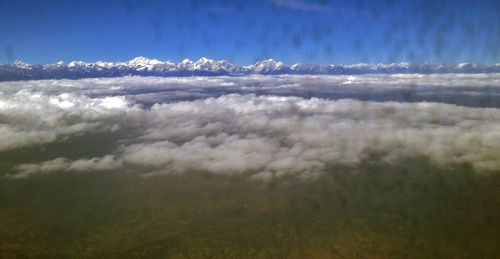
Himalaya
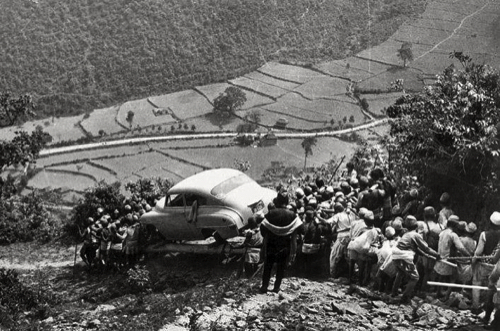
One of the first cars, imported via the harbour of Calcutta and carried across the promontory.

View of Bodhinath stupa and old trade route, mainly for yaks and horses.
History repeats itself: the first two hard roads in Nepal, one to China and the other to India, came about in the same way in the fifties.
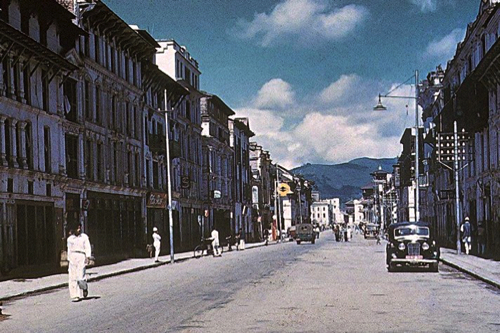
There has been much ado about the contracts already concluded, because the corruption by the officials involved was simply too obvious on both sides. Per generated unit of electricity the Nepalese state treasury gets not even a tenth of what the national electric company subsequently is required to pay for inland consumption.
New Road, Kathmandu
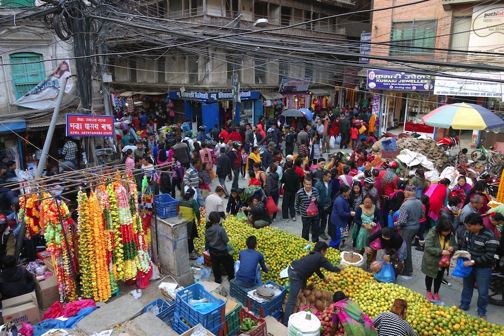
Jan 6, 2016: Load shedding hours have increased once again. From Monday, they went up to 86 hours a week from the previous 77.
Official explanation is that the depleting water in rivers feeding major hydropower plants because of inadequate rainfall has forced the Nepal Electricity Authority to increase load shedding.
For decades, Nepalis have heard their politicians wax eloquence about bringing load shedding to an end. The problem, if anything, has only worsened over the years. - Kathmandu Post editorial
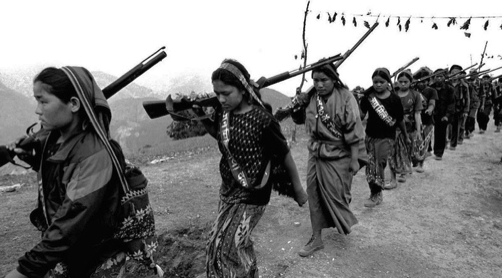
Maoist guerrillass, late nineties.
By the way, this is by no means the first boycott by India. The last one dates from 1989. The then King of Nepal had dared to buy weapons from China. The boycott lasted about eighteen months – once a black market has come into existence, there are many parties with an interest to prolong it.

Some of the Nepalese media seem convinced by now that India's BJP party follows another agenda than the sudden and strong solidarity with one specific Nepalese ethnic group, the Madhesi.
Incorporation is no paranoid thought, there are historical examples: Sikkim and Bhutan. Other neighbouring countries such as Bangladesh, Sri Lanka and Pakistan know all about it, with all these countries India is or was at odds, to put it mildly, for similar reasons.
The old palaces were heavily damaged as well.
Meanwhile, however, a new, more general uncertainty seems to emerge in Nepal. Some columnists question openly and possibly for the first time in history: who or what actually is Nepali ? The very term only dates from the sixties.
As one of them wondered: in how far is Nepali in fact an imagined community ?
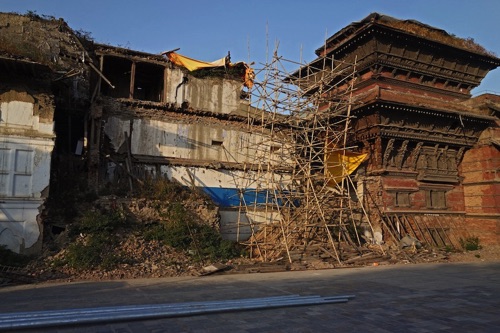
Until the sixties ‘Nepal’ had for centuries been understood to be the Kathmandu Valley – and only in the second or third instance the surrounding country.
Shah/Rana palace left, Malla palace right.
After all, it was only with the 1991 census that we came to learn about the number of the various caste and ethnic groups living in the country. In 2011 58 caste and 64 ethnic groups have been recorded. Deepak Thapa

At the fall of the Malla-kings, the current state of Nepal was put together by conquests and for some 250 years suppressed and exploited from Kathmandu by Ghurkas and Ranas, who kept it isolated from the rest of the world. There was hardly any experience of a national unity.
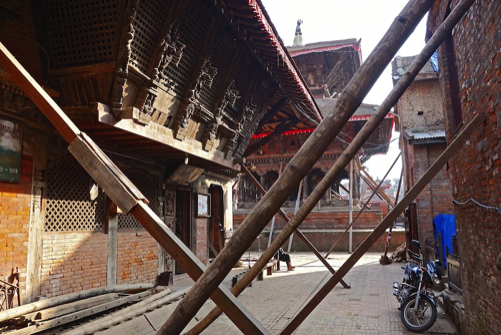
At the fall of the Malla-kings, the current state of Nepal was put together by conquests and for some 250 years suppressed and exploited from Kathmandu by Ghurkas and Ranas, who kept it isolated from the rest of the world. There was hardly any experience of a national unity.
For centuries the Himalayan region has been inhabited by peoples who immigrated from all directions and brought along their own languages and religions – which created a rich palette of diversity.
Shah and Rana domination left, Malla Kumari home right. (photo c Katipur)

You could argue that Nepal was kept together for 250 years by the fact that British India preferred preselected recruited quotas of Gurkha soldiers to the rule over a poor, sparsely populated landscape with endless uncontrollable, inaccessible mountains and valleys.
(By the way, Gurkhas presently form the largest unit of the UN peacekeeping force and are still at work within the armies of both the UK and India.)

Old picture of the Kathmandu valley.
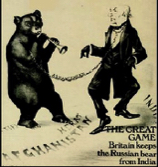
At the same time, the dictatorial regime in Kathmandu stayed safely out of range during The Great Game.
You could therefore argue that Nepal only became some sort of a unity when its borders opened to the rest of the world in 1951.
But how does a country with thirty million people remain politically and culturally autonomous next to a neighbour with over a
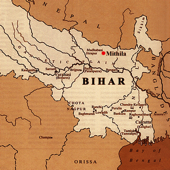
Within half a century Nepal has fought itself from a medieval kingdom into a modern republic and distinctly established itself on the world map. You only have to look across the border to the poor state of Bihar to see that – all the more so with a modern constitution – they did not do so badly. Even in comparison with the large next door neighbour, that since independence has been familiar

Without a constitution, there was no new government and therefore no National Reconstruction Authority until last December. Despite all incoming and pledged aid, hardly anything concrete is being done for the people who lived in the half-million homes swept away in the middle mountains. And as long as India maintains the boycott, nothing can possibly change.
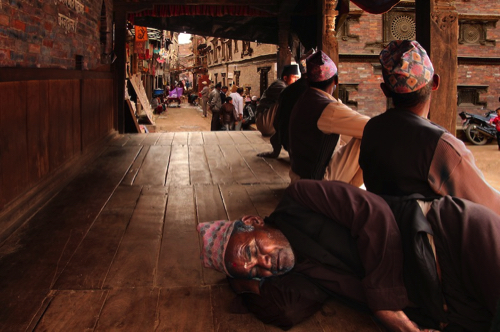
The international community liberally launched humanitarian assistance on an unprecedented scale, most notably led by India, Japan, China, and the United States. Equally generous were the financial commitments for reconstruction—to the tune of $4 billion—by bilateral donors and multilateral institutions like Asian Development Bank, World Bank and International Monetary Fund.

Understandably, expectations were high and there was consensus on accelerating reconstruction with the accepted ‘build back better’ principles. However, the delay in decision making by the government, the seemingly sluggish bureaucracy, and the egotistic political infighting around the National Reconstruction Authority (NRA) frustrated the quake victims and international community.

The National Reconstruction Authority -bill was passed eight months after the earthquake and key decisions of the previous government overturned to suit political interests. While the political apparatus appeared colder and more callous than expected when it came to accelerating the reconstruction, the increasingly lethargic bureaucracy seemed inept in swiftly handling normal bureaucratic assignments. Chandan Sapkota
With just a corrugated zinc roof.
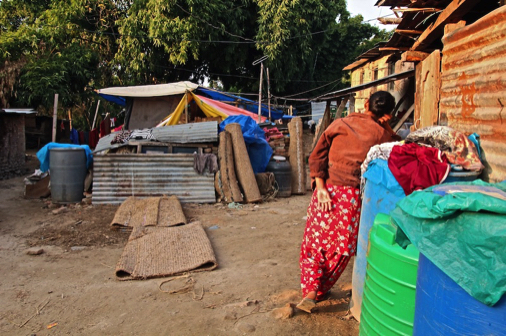
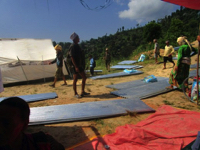
For example, small huts made of steel frames were installed which the villagers themselves had to fill with bamboo mixed with clay to withstand the monsoon rains. For them to survive the present winter cold that way, however, is a lot harder.
Besides, often mainly the elderly stayed behind to take care of their

Confectionery, working on wood fire, in the back of the store.
Nov 30, 2015- UNICEF has warned that more than three million children under the age of five in Nepal are at risk of death or disease during the harsh winter months due to a severe shortage of fuel, food, medicines and vaccines. -Post Report, Kathmandu
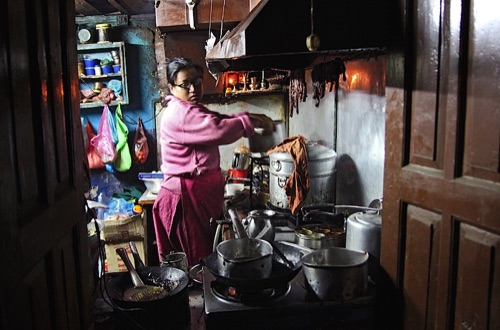
By hermetically sealing off a landlocked country, India not only shows contempt for international law, but follows a blatant strategy of destabilization as well.
To anyone familiar with Nepalese politics, the picture emerges of a baseball stadium: the ball seems to go over the fence, everyone in the stadium runs in that direction, unabashedly climbing and trampling on each other to get their hands on the ball of some $4 billion.
In absence of gas and electricity, families try eateries that managed to get some butane in the black market.
Kosh Raj Onta, the disgraced chief of the Armed Police Force, who was suspended by the government at the recommendation of the Commission for Investigation of Abuse of Authority (CIAA), has admitted to his involvement in embezzling state coffers by producing fake bills while supplying

Jan 5, 2016- How is the government tackling bad governance: a) by creating a bloated Cabinet; b) by lavishing ex-officials with obscene perks and privileges; c) by taxing and embezzling relief materials meant for earthquake victims; d) by circumventing rules to elevate one’s party-promoted hospitals—where senior leaders own huge stocks.
If you picked only one of the above, you are wrong. The correct answer is: all of the above - Sujeev Shakya
Old temple, collapsed house, motorbikes without gasoline.
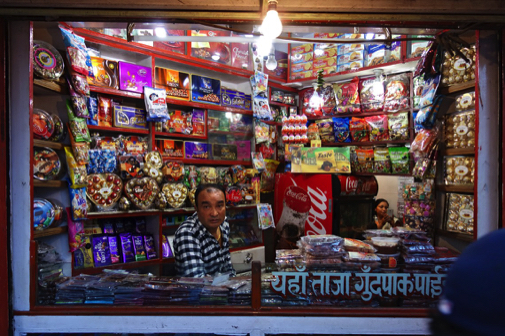
Given the corrupt history of the political parties in the country, one can easily conclude that the only reason behind the months-long wrangling over the NRA is the money pledged by the donors for the reconstruction projects. International donors have pledged over $4 billion for reconstruction. In addition, the government has allocated about $700 million for the current fiscal year. The parties are eying to use the reconstruction fund to influence politics rather than implement the reconstruction projects in a fair manner.
The situation is worst at the local level. Local bodies, which are running without elected representatives for more than 13 years now, are at an almost dysfunctional state with the absence of Village Development Committee-secretaries, the nodal points in local bodies. - Bhadra Sharma

As in so many Asian and African countries, you only have to look around to see the approach of a very different earthquake: a youthquake. How much faster the rebuild would take place if the young did not have to go abroad for work and build a showy stadium or the next highest tower in the world. What if they could get started for themselves, in their own village?
A country cannot develop by merely exporting its workforce.
Every day, a larger number (1,800) of the working age population leaves for foreign countries in search of manual work than the number entering the job market (1,400).
It has disrupted the overall development process and resulted in socio-economic problems which might have undesirable consequences in the future for Nepal. Rajesh Gautama

For how would the corrupt political garde cope if five million units of testosterone returned home? How do you stabilize a country where 4.6 million persons over sixteen do not have or cannot get a ‘citizenship certificate?
Citizenship certificate is the primary identity and is the basis for acquiring other identity documents, enrolling on the voter list, registering marriage, buying or selling land and even opening a bank account. -Post Report
Registering a child for college or university is problematic as well. -
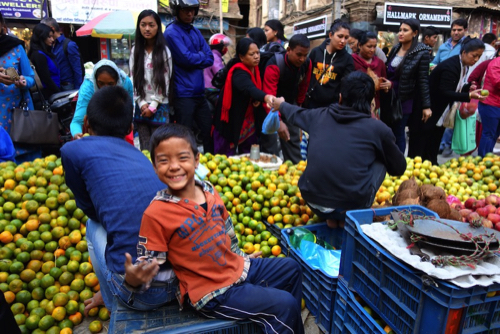
First, it may radicalise the youth of Tarai and trigger armed violence in the region; second, the separatist agenda may gain momentum, leading to the demand for a separate nation instead of just an autonomous province as it stands now; and finally, communal violence between the Pahadis (hill-people) and the Madhesis (Tarai-people) may erupt. Seema Pandey

The Indian politician Prakash Verma urged his government to make its position clear on the straining age-old ties with Nepal and the initiatives taken to resolve the crisis. He added that the Indian government should respect Nepal’s sovereignty.
“Does it mean that we have an ulterior motive behind our apparent good gestures?” Verma wondered. He warned the government to take steps before the ongoing Madhes movement goes into the hands of radicals - Post Report

All those concerned about the future of Nepal should take this as a wake up call. The chills of winter will wipe the smiles from innocent faces in the earthquake-ravaged hills of Nepal; human trafficking could increase and more could migrate to the Gulf countries and if worse comes to worse, Nepal as a country might even be obliterated.
Thus, to avoid such disastrous consequences, it is imperative to help Nepal revert back to normalcy. For that, the Indian government should shed its arrogance while the Nepali government should reconcile with its people. – Atul K Thakur, Indian writer
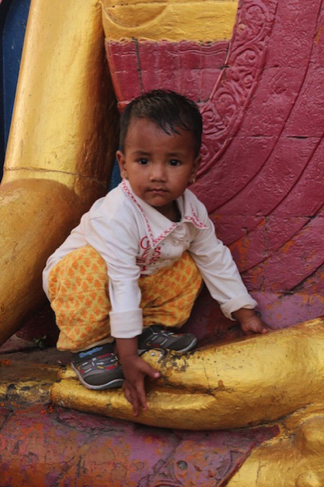
All photographs and texts ©Kashba Ais Loupatty & Ton Lankreijer.Webdesign:William Loupatty
according to the politicians involved and international experts.
international spotlight, its politicians dared to press on.
India was cross - at least the ruling extremely conservative Hindu party, BJP. She had publicly told the Nepalese government to delay the introduction of the new constitution. Among other things, until after the election in the neighbouring state of Bihar. Soon on FB a list ofzeven eisen was leaked.
c: http://www.essenceclick.com.np The last supper of ethnic minorities in Nepal.
The Indian Express. ‘By promulgating our own Constitution, we have only asserted of our sovereign rights, something that is not directed towards any country.’
could publicly state that the people of Sikkim had ‘legally’ voted to become a state of India.
flee are to be kept open.
In the media President Modi maintained, for example, that Nepal's new constitution should not introduce separation of church and state, but proclaim itself a hindu state - something that would cost him his head domestically, with at least 20 percent non-Hindu nationals.
any border at all with Nepal.
He lost the elections in Bihar so dramatically that mutiny arose within his party.
Even the Dalai Lama - who received a permanent residence permit 55 years ago from president Nehru on the condition that the political leader of Tibet was not to interfere with Indian politics - ventured to put his oar in:
‘If I may say so, the Bihar results
have shown that a majority of Hindu people still believe in harmony.’
People were associating the ‘intolerance debate’ in India with Nepal.
The Indian writer Sanjay Kumar in his article ‘An uprising against intolerance in India’ states that in India ‘the perception is gradually building that Modi is using the slogan of development merely as a mask and that the real agenda of his government is to convert the nation into a hindu state. Ratyush Nath Upreti,, lawyer.
So when neighbouring Nepal – often called ‘little brother’ by Indian politicians – changes from a hindu kingdom into a secular republic through a new constitution, it is contrary to the BJP agenda.
For some time, the media in Nepal thought they knew why the BJP so firmly supported the demands of the Madhesi in the Tihar: ‘To punish us for not waiting until the election in Bihar was over.’
The undemocratic position of the government in Kathmandu is somewhat understandable: it fears an even greater Indian involvement with domestic politics once Madhesi could constitute a majority.
Therefore, they prefer to arrange the voting rights through the federal system of states,
whereby the wishes of the Madhesi would not define those from the hill-minorities.
The Madhesi position speaks for itself: in a democracy each individual has the right to cast a vote.
To further elucidate the stalemate, the following. Nepal is roughly similar to England in size and shape. The country can be divided into three long, thin strips: high, medium and low mountain range and subsequently the plains to the border with India. For centuries, the administrative power has been situated in the central mountains: the capital Kathmandu valley.
The plains are called the Tarai. For centuries this sun-drenched strip was sparsely populated by peasants. During the last decades, however, great changes took place in the Tarai. Its population now constitutes over fifty percent of Nepal and its industry close to seventy percent.
Nevertheless, the Tarai still hardly has any political input. Traditionally the hill people view the Madhesi rather as Indians than as Nepalis: ’They all wear dhotis(no longer so) and don’t even speak Gurkhali’ (in remote valleys people speak this lingua franca just as poorly).
Reading free newspaper.
blackmail.
In response, the government in Kathmandu deployed the army: forty deaths.
President Modi reacted with a historically charged remark: we will defend every Indian living on that side of the border (read: Madhesi). Promptly the Nepalese army withdrew – which made a columnist wonder whether Modi had not accidentally prevented a new civil war in Nepal.
Landlocked countries.
To emphasize Narendra Modi’s warning, the BJP set up an official boycott against Nepal. Apparently the party had forgotten that decades ago all the countries in the world signed the international treaty that guarantees landlocked countries access by road and use of nearby ports.
So a day later the BJP announced that it was an ‘unofficial boycott’, again a day later it realized how amateurish and silly this sounded and ever since insists that ‘the unofficial boycott’ does not exist: it is an internal conflict.
Meanwhile, the Indian customs has been stopping all im- and exports since September 2015.
The blockade came immediately after the promulgation of the new constitution on September 20.
Given that almost 60 percent of Nepal’s trade is with India and it is the only supplier of petroleum fuel and cooking gas, the disruptions at major custom points are virtually stalling and derailing economic activities. - Chandan Sapkota
In the meantime there is a lack of everything with the lack of fuel further intensifying the problems.
As usual, at once a black market popped up:
people with mopeds run daily to and fro to fill their tank as often as possible.
Night buses replace passenger seats with jerry cans (and, of course, already some went up in flames). It helps that Nepal traditionally has an open-border policy with India – any other form would hardly be possible to maintain or to finance.
The supplies blockade has abetted black market transactions, and distorted household and business incentives. Smuggling and black marketing of goods and fuel are now considered more lucrative than farming and other productive means of livelihood. Cartels, syndicates, unions and lobbyists are running the show more freely than before, affecting decision-making and operations at key state-owned enterprises and in almost all sectors. - Chandan Sapkota
Read: there is even more corruption than before.
Strictly controlled distribution of twenty half-filled butane gas cylinders.
Nor is there butane to cook. Result: increased logging. Consequence: increased erosion. Effect in the not so long run: rising riverbeds in India and Bangladesh, which will eventually result in flooding, as in the eighties.
Other critical shortages in food and medicines are obvious. Industries cannot help but close, the overall damage rises rapidly - especially for an already poor country with little reserve that recently got to handle a natural disaster as well.
Nov 26 2015 - An additional 700,000 to 982,000 people were pushed below the poverty line by the earthquakes. The monetary value of the damage was estimated to be about $6.7 billion, almost half of it attributed to damage of housing and human settlement.
The only step that has been taken so far to help the victims is more a tokenism:
the decision to provide N.Rs 10.000 ($ 104,-) to earthquake survivors to help them 'stay warm' during winter. Even this offer is so meager that it stands more as an
insult to earthquake survivors rather than a reprieve. - Kathmandu Post editorial
The international political silence is striking; silence equals consent, it seems. China pledged aid, but continued to linger and up to now mentions 'gifts' rather than structural solutions.
Possibly China is still puzzled why
India did not press ahead – like they annexed Tibet – when in the fifties Mao and Nehru decided upon the Himalayas as an obvious boundary between the two giants.
Initially China annexed Mount Everest as a whole, but after protests by Nepal let the dots run over the top.
The US ambassador in Nepal gives headmaster-like interviews in the first person plural, and even indicates why the US does not speak to India about the boycott:
The US considers itself to be part of the Pacific Rim community. We have been looking very seriously into how to integrate in South Asia, South East Asia and Indo-Pacific Economic Corridor concept. - US Ambassador Alaina Teplitz
Speaking through Air Chief Marshall Arup Raha, India said essentially the same:
India is particularly wary about China’s increasing economic and security ties with Nepal.’ Arup Raha’s statement says that India’s foreign and defense policies are being designed to contain China’s growing influence in South Asia. Second, he said that increasing economic and military ties with Nepal were part of “strategic moves by China to contain India. Geostrategic disaster
On maps of Indian websites, Nepal is often depicted as a state of India.
Dec 24, 2015 - Harsha Kakar, Indian Defence Review: ‘In the past few years, the US has become India’s largest supplier of military hardware. It has overtaken Russia in meeting India’s defense modernisation plans. In addition there is an increase in military-to-military exchanges, including, in the recent past, participation in naval, air and army exercises. The interaction at the strategic level enhances close bonding. The recent visits by the foreign and the defence ministers have helped enhance the level of bonhomie and military interactions.
While for India, the relationship increases its standing in the international community, for the US it makes above all strategic sense. In the present environment there are challenges for which the US needs India’s support. The first is to counter a belligerent China. The push for control of the South and East China Seas brings forth China’s hegemonistic designs. The only two navies that have the capability to counter this design are those of India and Japan. Thus, by involving Japan in the naval Malabar exercise, along with the US, India has signalled its unwillingness to accept China’s claims.
During the Japanese Prime Minister’s visit numerous military agreements were signed which provoked sharp criticism from China.
India has for some time enhanced its patrolling of the piracy-infected seas off the African coast. Thus piracy has drastically reduced.
It is easier for India to maintain a naval presence in the region than for the US; it also suits Indian interests as it directly affects its maritime trade.
India is presently in talks with the US on the Logistics Support Agreement (LSA) which was desired by them (the USA - TL), but the UPA (progressive coalition in India – TL) was unwilling. It is aimed at permitting access to military bases and ports, resulting in easier conduct of joint exercises besides expanding their scope and level of conduct. It would finally result in enhanced trust levels for flow of military technology and co-production of hardware.
India contributes to economic and infrastructural development but provides training facilities for military and police in Afghanistan as well. - Harsha Kakar, I Indian Defence Review
Bus conductor
The US says it wants to withdraw from Afghanistan and tries to counteract the influence of Pakistan and China in the area by increasing India’s presence.
For India, the US holds the key to a number of international organizations, whether it is the UN Security Council or the Nuclear Suppliers Club.
India has had problems with its military imports from Russia. The shortfall in spares and the delay and increased cost of the aircraft carrier are some recent examples. Until its domestic defense industry comes of age, India would need to depend on imports to enhance its capabilities to continue to be a military power in Asia.
Therefore India has increased its import base and turned to the US. There are a few stumbling blocks. US laws permit it to cut off armament sales and supply of spares arbitrarily. Thus, any action by India contrary to US interests could affect supplies of military hardware. This was one of the reasons that India avoided signing deals with the US earlier. - Harsha Kakar, Indian Defence Review
covered for eighty percent by fossil fuels.
Hydropower – cheaper, cleaner, safer and more efficient – sparkles on the majestic horizon, but is largely situated in Nepal – still a young and independent republic.
And given the ease with which the world has been fighting mercilessly over oil for over a century…
Meanwhile large business interests got involved. India decided to invest in various, capital hydroelectric power plants on Nepalese territory. On November 25, 2014 Modi flew over – none of his predecessors these past 17 years had seen any reason to – to witness a signing valued at $ 2.4 billion for two powerplants.
In 2012 China had already pledged a project worth $ 1.6 billion. As well as in March 2014 an additional grant of $ 145 million for the upgrade of a 71-mile road that joins Kathmandu with the Tibetan border.
'India has often ignored its small Himalayan neighbour but has been unnerved by China's growing presence in the country.’ - mailonline
billion?
Political autonomy: just like the former kings, all subsequent politicians flew ‘for a health check’ to Delhi at every important decision. Economically Nepal depends on India for close to eighty percent.
Cultural autonomy: according to many outsiders the metropolitan valley in particular has become 'very much Indian.’
Until thirty years ago plenty of temple roofs rose above the roofs of shouldering homes, today you have to know where to find them.
The religions or worldviews of Nepal and India largely correspond, including the present neoliberal view. For decades, they have been watching the same Bollywood movies and Indian TV channels. Almost every Nepali understands Hindi, not vice versa.
with nonstop ethnic and religious hotbeds and doesn’t have one unequivocal identity either.
piece of land, some cattle and perhaps a few grandchildren. The young went to the city or abroad for education or work.
goods to the units of the paramilitary force.
“He managed to post a bail of Rs 100 million within an hour. This shows the unbelievable amount of property he has amassed,” said the official. Post Repor ,Katmandu
Also see: Nepal
4 dec. 2015 17:47
Since the seventies we have been visiting Nepal at least twice a year. Last November, we asked friends and acquaintances how they fared during the earthquakes in April and May.
In the evening we noted their experiences, two recall more than one.
Reading them again, I notice how anecdotal their stories had already become, as new threatening situations presented themselves every day due to a persistant Indian boycott.
Occasionally minibuses appeared at a street corner. Obviously they had scored some gasoline. At once they were surrounded by dozens of people.
By buying soda bottles with orange gasoline on the black market, we could move around in a small taxi on roads that were reminiscent of the seventies: empty and quiet.
Rather selfish, sure, but hopefully excused by our wish to fulfil overdue obligations with forges, workshops and artists, for surely if there was one thing they could use during these hard times, it was money.
Money Runner: In total more than half a million homes in the hills have been destroyed. At home in the Gorkha district, several hundred were swept away. During the Dasain festival I took my elderly father and mother to my house. In that iron emergency hut with bamboo the festival couldn’t really be celebrated, better to stay in our rented rooms here in Kathmandu.
My boss is from the same village. He was the only one who had a concrete house built over there. Pretty much the whole village camped weeks in and around that house. With tents and canvasses and the like.
Son statue maker: At that very moment we were driving in the car across the bridge to Patan. The bridge swung from left to right and back. My parents grumbled once again that I was driving too recklessly. Only when I put my foot down, they looked up and their murmur stopped abruptly.
Trader: It was Saturday, so I was taking my shower a little later. On the fifth floor. I immediately realized what was happening, having experienced the same in 2011. I grabbed a towel and ran down the stairs, slipped, lost my towel, grabbed a small jacket of one of my children and ran outside.
There I halted in my bare ass till the quake stopped for a moment. I thought I’d go quickly upstairs to put on a pair of pants. Too embarrassing in front of my children. Once above, it started again. And again running, slipping and falling down. With a bruised shoulder and wounded knee, I joined the others in the open field.
We more of less slept there for three weeks. In fact, we didn’t do much for two months. It was rainy season anyway. From the open field I looked at every vibration of the house I have managed to build. It has five floors and stands separate, so at times it swung from side to side.
According to my wife, each time my head swayed along. My only thought was: If this collapses, where is my family going to live? By now I’m too old to earn a new home.
Receptionist (large hotel): Everyone lived and slept here in the lobby. First on the sofas and chairs, later we dragged down mattresses. Sleeping on the terrace outside seemed too dangerous: falling rocks. The hotel stands rather tightly built in. Nevertheless, never did I have such accommodating guests. Their numbers quickly dwindled, they were all trying to get away and go home. Later on, foreign rescuers took their rooms. Presently, the hotel has quite some unused capacity, eventually it will be a very bad year, yes.
Student: My sister and I were shopping in New Delhi when my brother phoned from the United States. At first we did not understand him well, did not take him that seriously, he often has these excited stories. But we promised to look for a television and watch the news.
What we did not realize at the time was how terrible the news in India is on commercial channels, it is mainly about attracting attention and selling products. Within minutes, we were convinced that the Kathmandu Valley had disappeared into the earth. Together with all our relatives.
For an hour or so we were in a kind of shock, alone in the world, nowhere to go anymore... In the end the effect was that, however bad the news, it was better than we expected.
Newari homeowner: Mostly the neglected, traditional houses collapsed. Neglected because there was no money or because no one lived there anymore. The entrances are often too low and the rooms too small for the new generations. Or they were unoccupied because the parental home had become a legacy issue: how to divide a small old house between two, three sons? Some idiots build a wall right through the middle. Once brothers are legally separated, they usually sell it for the value of the plot.
The houses and temples that were well kept, however, remained largely intact here in the valley. Because they lean against each other, but also because they actually have been built in a sophisticated manner: once a beam or a pillar is rotten or decayed, it is fairly easy to replace. In fact, these old houses are quite flexible. That’s why they have lasted that long.
All the concrete structures survived because they are still relatively new. Who knows how they will cope with the next major quake, another eighty years or so from now? They were often built so high and so close together…
Goldsmith: (usually in lotus position behind very low workbench) I just couldn't manage to get up! I was lying on the floor and saw the marble floor of the stairwell actually make waves. In my view I laid there for a long time. At times the marble came up so high that I couldn’t understand why it didn’t break. Apart from a few cracks everything remained in good order.
Luckily it was Saturday, so there was no school next door. The top of that building, also six floors, bent all the way towards ours, it seemed as if they were going to bang their heads.
Trader: Around the stupa was enough open space, but no one was allowed to spend the night there. To prevent theft of sacred objects. In the afternoon we drove together, three families, out of the built-up area. On an open piece of land we parked two cars next to each other and tied a tarp between them.
In the morning we packed up and went back to clear up the rubble. We continued that way for a couple of weeks. Until it began to irritate everybody so much that we took the risk and slept at home again.
Silversmith: Our kitchen is on the top floor. It was 11:55, Saturday, I was already eating my lunch. Suddenly the water filter fell over. Startled, I wanted to get up but had to hold on to the table. Only when two bowls fell from the cupboard on our stone floor and crashed, I realized an earthquake was happening. For my son's coming birthday I had bought a bottle of red wine and hid it up high. Only when the bottle smashed with a big red bang, did I get a bit scared and realized that this quake could get worse than the one of 2011.
Curio seller: For years we have been hanging around the temple stairs here with our merchandise. Fifteen years ago, these temples were restored with foreign money. Someone made quite a lot of money back then. Whenever the old beams were a bit rotten, they were planed here and there and reinserted. So when we became aware of the earthquake, we all immediately backed away from the temples. Then it fell silent for a while, they still stood erect and we returned to get to our belongings to safety.
But then the second half started – of what later turned out to last 55 seconds in total. With enormous creaking two of the temples collapsed. Fortunately in the opposite direction, otherwise we would have been injured, at the very least.
Suddenly I realized I had to be with my wife and children and ran home. Past a large group of Indian tourists with a few hysterically screaming women, I remember. But at home they screamed just as loudly when they saw me approach. I did not realize that the dust of the temples made me look like a white ghost.
Brass statue maker: I was standing on the roof in the sun. I sensed it at once, I experienced the one in 2011 and decided not to run this time. Of course, I doubted constantly whether it was the right decision. But to run down the stairs with my daughter in my arms seemed equally dangerous. Bent over my child, I waited. Then it fell silent for a moment. I threw her onto my back, ran down the stairs, into the street, where everyone was standing whining, watching his house.
Woodcarver: In our village only twenty-two houses completely collapsed. The remaining twelve were too much damaged to live in. Too dangerous. The whole village left for the next village, where there was less risk of landslides and mudslides during the monsoon.
With iron and bamboo, some temporary additional huts have been built. Everybody waits for the government, which has announced many things – but has done nothing as yet. Well, that's not entirely true. The victims received twelve thousand rupees (€ 120, =) for food, for the time being.
Stone carver: At the first quake, there was much damage around the roof. At the second, sixteen days later, it finally collapsed. We now live under corrugated zinc. No idea how we’ll manage in winter. Maybe we will sleep together in the little side room that’s still standing.
We can’t carve here any longer. My brothers now work on a few large statues in an open field on the outskirts of town. Too heavy to steal.
Everyone says that if you start to restore your house yourself, you cannot claim money from the government later on. So for the time being we do nothing. The little money we have, we’d better invest in our work.
District foreman: Many countries came to help us. The rescue forces, our government quickly sent them home and we have not seen any of their donations so far. Officials claim that later on, perhaps, you just may be able to get a mortgage at 2% interest. We were not going to wait for that. We started the work in this area ourselves. We placed zinc roofs, restored windows, took statues to a safe place.
No, not everything propped up is about to collapse. Sometimes we posted trestles as aprecaution, sometimes because of cracks that must be mended first. Most of the struts may remain in place until the family has money for a newbuild. If you look carefully, you may still find struts that date from the 1934 earthquake.
Hotelier (very tall, narrow guesthouse): Together with my family, the guests slept out here on the empty square in front of the monastery. I had to stay and sleep here in the lobby because a guest from Taiwan refused to go outside even during the first earthquake. “Oh, this is nothing compared to what we know in Taiwan," he shouted through the door. I can hardly imagine. Anyhow, I couldn’t leave him alone either. If anything happens to him, I get the tourist police all over me.
The other ten, twelve guests ran through the lobby out to the square at every vibration, sometimes sleepy and half-dressed. No matter whether it was day or night. We ourselves are still living on the ground floor, my wife does not want to go upstairs. She’s still doesn’t have the guts, I think.
Statue maker: What sticked in my memory the most is that strange sound of the earthquake itself. I cannot describe it. High or low, I cannot say. Imitate? Difficult. The dogs sort of howled, as when they hear high notes. The crows heard it too, I think, but already before the earthquake, because they flew wildly screaming among each other, sometimes even against each other, as if they were lost.
Carpenter: Bungamati is a farming village. Traditionally they do a lot of woodcarving. Judging from their housing you already can tell that it is nevertheless a poor village. Many of the small houses are not damaged but just collapsed. They will have been in the fields, for they only had four deaths. In Bhaktapur, a similar kind of village, the count rose to over four hundred. Just before the quake I sent my fourteen year old son to Bungamati to pick up something. With tears in his eyes he returned: 'Papa, I just went home. Everyone there walks around crying …'
Brocade trader (sitting on the floor in an long, narrow shop): Of course, I was open. Never in my life had I experienced an earthquake, I am from India. The rolls with brocade are closely clamped together here, I have little space. Suddenly the rows began to bulge. I got up and tried to hold them, but naturally my arms were much too short. Then I got the whole load on my neck from the other side. Fortunately, only textiles. But I could not flee into the street. The vibrations had made the shutters come down. I got stuck. Without knowing what was going on outside. Eventually, my brother pulled up the fence from the outside.
Only a week later I started cleaning up. I found it difficult to start sitting here working again.

